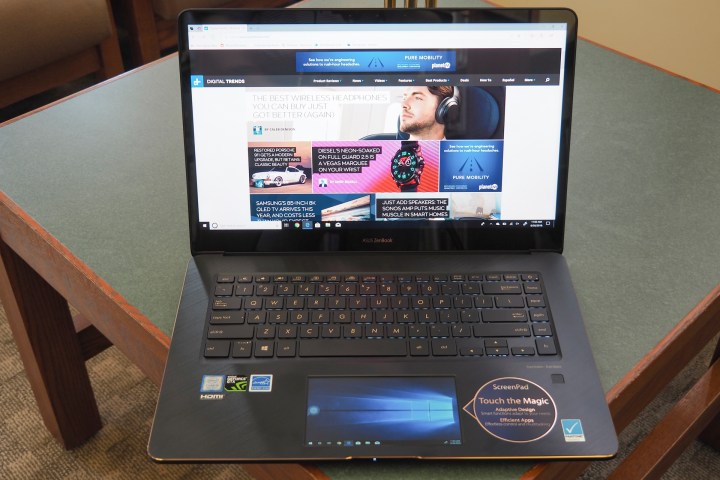
Your laptop needs more than just updated specs and clean design to stand out these days. Asus has taken that to heart in its most recent premium laptop, the ZenBook Pro 15. What’s the stand-out feature? Well, Asus calls it the ScreenPad, a second touchscreen built right into the touchpad of the laptop.
Asus has taken Apple’s Touch Bar concept to another level by layering an IPS LCD display over the swiping surface and implementing some interesting functionality. The innovative new touchpad technology is certainly ambitious, but is it actually useful?
The ScreenPad as a bigger, better Touch Bar
To consider whether the ScreenPad brings value to the laptop experience, we first need to consider what it actually does. And on paper, that’s quite a bit.
To begin with, there are a few modes that you can trigger via a keyboard function key. There’s the ScreenPad mode, which enables the various apps and utilities that Asus and third-party developers can create using a software development kit.
Why would you want a full-sized, Windows 10 desktop on a 5.5-inch screen? We don’t know. Haven’t figured that out yet.
Those apps are the most ScreenPad’s most visible features, and where there is the most promise. Fire up the ZenBook Pro and swipe down from the top of the ScreenPad, and you’re faced with a customizable row of icons. Click on one of those icons, and the touchpad transforms into an optimized interface for a specific task. It’s kind of cool.
For now, the list of options is relatively short. If you’re a Spotify user, then you can control the playlist and playback using the ScreenPad. There’s also a stand-alone music player for those who prefer local tunes. Meanwhile, if you fire up YouTube (in Chrome only, for now), you can control playback using the ScreenPad or sign Adobe PDFs. There are also some useful utilities like a numeric keypad, calculator, and calendar app, all of which are more helpful than on the Touch Bar thanks to the increased screen real estate.

But the best example of a viable use case for the ScreenPad is the Office tool. When you open an Office app, a set of useful edit controls pop up on the touchpad that Asus says have some predictive capabilities (that I didn’t notice in this version). And those edit controls are right where you need them – imagine using the touchpad to select a word and right there next to your finger is a set of formatting controls. That’s genuinely useful, and it’s also customizable. We can imagine that kind of functionality being extended to any number of apps, which would be a real boon to productivity if the integrations are well designed.
It’s a short list for now, but it does a solid job of demonstrating just how useful the ScreenPad could be. In theory, at least.
The ScreenPad as a second display
The second bit of functionality is the Extension Display mode, which turns the ScreenPad into a small secondary display. Essentially, the ScreenPad can act just like an external monitor embedded right in the keyboard deck. This is where things get a little strange.
The ScreenPad feels at least as natural to use as Apple’s Touch Bar, and unlike the Touch Bar, it doesn’t take away the notebook’s function keys.
Windows 10 UI is difficult to control in extension mode — everything’s quite tiny at the default Full HD (1,920 x 1,080) resolution. You can switch between cursor mode, which lets you try to control a tiny cursor to select the tiniest elements, and touch mode, which feels more natural but turns off cursor control on both displays. Fortunately, you can switch the ScreenPad to a more reasonable 800 x 600 resolution.
Why would you want a full-sized, Windows 10 desktop on a 5.5-inch screen? We don’t know. Haven’t figured that out yet. It’s certainly best for Windows 10 apps that are made for touch as compared to legacy Windows or web apps that aren’t. In case you haven’t noticed, there aren’t a ton of those. Nevertheless, it’s an intriguing feature that can be useful for things like playing a YouTube or Netflix video while you’re working (assuming again, that you aren’t using the touchpad).
Okay, so, does it help you work?
Asus has an interesting concept with the ScreenPad, and the execution is surprisingly good. It’s larger than the Touch Bar and in a more convenient location. We constantly access our touchpads (if we’re not using a mouse, of course), and that makes it a natural place to include more functionality. In this respect, the ScreenPad feels at least as natural to use as Apple’s Touch Bar, and unlike the Touch Bar, it doesn’t take away the notebook’s function keys.

However, there are some significant issues as well. The main problem right now with the ScreenPad is it’s too buggy. Features sometimes work, and sometimes they don’t. The ScreenPad software resets on occasion, and it can lock up — with the only apparent way to recover being to reboot.
Outside of bugs, there’s a fairly large limitation to the ScreenPad apps in that the touchpad functionality turns off. That means that simply opening the music app to play some tunes, for example, limits you to using the touch display (or a mouse) to control things on the primary display. That’s an unfortunate constraint, and it makes ScreenPad apps a somewhat dubious proposition.
But if Asus can fix the bugs and add some polish, and if third party developers create useful implementations, then the ScreenPad could be a useful enhancement that we’re sure other manufacturers will duplicate. Asus looks to be expanding the ScreenPad concept to other laptops with its new NumberPad feature in the new ZenBooks, so we’re looking forwarding to see more uses for this interesting concept.






